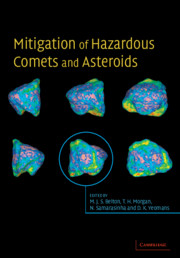Book contents
- Frontmatter
- Contents
- List of contributors
- Preface
- Acknowledgments
- Glossary
- 1 Recent progress in interpreting the nature of the near-Earth object population
- 2 Earth impactors: orbital characteristics and warning times
- 3 The role of radar in predicting and preventing asteroid and comet collisions with Earth
- 4 Interior structures for asteroids and cometary nuclei
- 5 What we know and don't know about surfaces of potentially hazardous small bodies
- 6 About deflecting asteroids and comets
- 7 Scientific requirements for understanding the near-Earth asteroid population
- 8 Physical properties of comets and asteroids inferred from fireball observations
- 9 Mitigation technologies and their requirements
- 10 Peering inside near-Earth objects with radio tomography
- 11 Seismological investigation of asteroid and comet interiors
- 12 Lander and penetrator science for near-Earth object mitigation studies
- 13 Optimal interception and deflection of Earth-approaching asteroids using low-thrust electric propulsion
- 14 Close proximity operations at small bodies: orbiting, hovering, and hopping
- 15 Mission operations in low-gravity regolith and dust
- 16 Impacts and the public: communicating the nature of the impact hazard
- 17 Towards a national program to remove the threat of hazardous NEOs
- Index
17 - Towards a national program to remove the threat of hazardous NEOs
Published online by Cambridge University Press: 12 October 2009
- Frontmatter
- Contents
- List of contributors
- Preface
- Acknowledgments
- Glossary
- 1 Recent progress in interpreting the nature of the near-Earth object population
- 2 Earth impactors: orbital characteristics and warning times
- 3 The role of radar in predicting and preventing asteroid and comet collisions with Earth
- 4 Interior structures for asteroids and cometary nuclei
- 5 What we know and don't know about surfaces of potentially hazardous small bodies
- 6 About deflecting asteroids and comets
- 7 Scientific requirements for understanding the near-Earth asteroid population
- 8 Physical properties of comets and asteroids inferred from fireball observations
- 9 Mitigation technologies and their requirements
- 10 Peering inside near-Earth objects with radio tomography
- 11 Seismological investigation of asteroid and comet interiors
- 12 Lander and penetrator science for near-Earth object mitigation studies
- 13 Optimal interception and deflection of Earth-approaching asteroids using low-thrust electric propulsion
- 14 Close proximity operations at small bodies: orbiting, hovering, and hopping
- 15 Mission operations in low-gravity regolith and dust
- 16 Impacts and the public: communicating the nature of the impact hazard
- 17 Towards a national program to remove the threat of hazardous NEOs
- Index
Summary
Introduction
It is a demonstrable fact that asteroids of all sizes and less frequently cometary nuclei suffer collisions with the Earth's surface. The impact hazard, which is defined in Morrison et al. (2002) as “… the probability for an individual of premature death as a consequence of impact,” has undergone considerable analysis with the conclusion that the greatest risk is from the very rare collisions of relatively large asteroids that can create a global scale catastrophe in the biosphere (Chapman and Morrison 1994). In the last decade, the question of how to deal with the hazard has led to considerable activity and advocacy on the part of the interested scientific community, and activity at government level has been stimulated in the United States, Europe, and Japan (a detailed overview is given by Morrison et al. 2002): there are now survey programs to search for objects that could be potentially hazardous; there are high-level calls for increased observational efforts to characterize the physical and compositional nature of near-Earth objects (NEOs) (e.g., The UK NEO Task Force report: Atkinson et al. 2000); an impact hazard scale has been invented to provide the public with an assessment of the magnitude of the hazard from a particular object; there have been considerable advances in the accuracy of orbit determination and impact probability.
Nevertheless, it seems that the question of how governments should go about preparing to mitigate the hazard needs some further attention.
Information
- Type
- Chapter
- Information
- Mitigation of Hazardous Comets and Asteroids , pp. 391 - 410Publisher: Cambridge University PressPrint publication year: 2004
Accessibility standard: Unknown
Why this information is here
This section outlines the accessibility features of this content - including support for screen readers, full keyboard navigation and high-contrast display options. This may not be relevant for you.Accessibility Information
- 4
- Cited by
